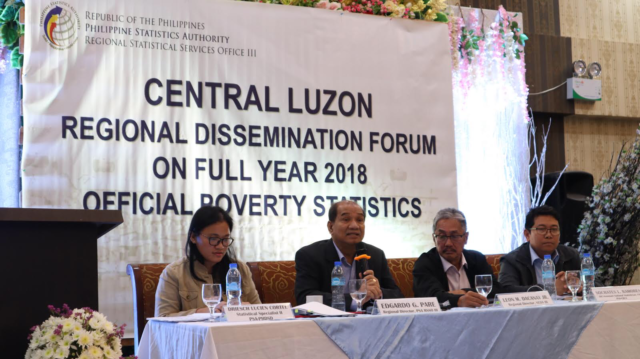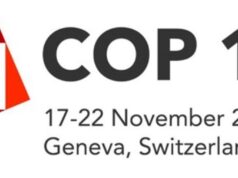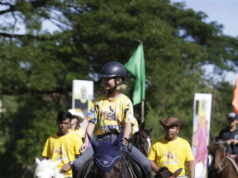Philippine Statistics Authority Regional Director Edgardo Pare (2nd from left) reports on the poverty and subsistence incidences for Central Luzon in 2018 during the Regional Dissemination Forum on Full Year 2018 Official Poverty Statistics. (Philippine Statistics Authority)
CITY OF SAN FERNANDO — The Philippine Statistics Authority (PSA) said Central Luzon is one of the better regions in the Philippines in terms of poverty incidence among population and households.
During the Regional Dissemination Forum on Full Year 2018 Official Poverty Statistics, PSA Regional Director Edgardo Pare said that of the 14 provinces nationwide belonging to Category 5 or those considered as “least poor”, five are in Central Luzon.
“Included among the least poor provinces are Bataan, Bulacan, Nueva Ecija, Pampanga and Tarlac. The remaining two provinces, Aurora and Zambales, meanwhile belong to the Category 4,” Pare said.
He added that the poverty incidence among families in Central Luzon in 2018, or the proportion of poor families whose per capita income is not sufficient to meet their basic food and non-food needs is much lower at 5.0 percent compared to 8.2 percent in 2015. Both figures were observed to be lower than the national poverty incidence which were estimated at 12.1% and 17.9%, respectively.
“Translating this into number of poor families in the region, the number went down to 140,000 families in 2018, compared to the estimated 210,000 families in 2015. This is significantly lower than the 2.9 million poor families accounted nationwide in 2018,” Pare explained.
In terms of poor population or individuals, Central Luzon also recorded a significant decrease in poverty incidence from 10.4% in 2015 to 6.9% in 2018 or about just 800,000 individuals living below the poverty threshold from the 1.2 million estimated in 2015.
Consequently, the subsistence incidence among Filipino families in Central Luzon, or the proportion of Filipinos whose income is not enough to meet even the basic food needs was estimated at 0.9% in 2018, which is way lower than the 2.0% recorded in 2015.
These figures were observed to be lower than the national subsistence which was recorded at 3.4% in 2018 and 6.4% in 2015.
“This means that 9 out of 1,000 Filipino families have incomes below the minimum amount needed to buy their basic food needs in 2018. The 0.9% translates to about 26,000 families in Central Luzon, which is about half of the 51,000 families recorded in 2015,” Pare said.
Among population or individuals in the region, the subsistence incidence was estimated at 1.5% in 2018 from the 2.6% in 2015 or about 173,000 Filipinos in Central Luzon out of the 5.5 million nationwide whose income fall short of the food threshold in 2018.
“These significant decline in the region’s poverty and subsistence incidences show that our collective efforts allowed us to gain the upperhand to curtail the cycle of poverty in the region,” Pare said.
He also urged all sectors to continue implementing strategies that will sustain this momentum and the vibrant economy of Central Luzon as a whole.





